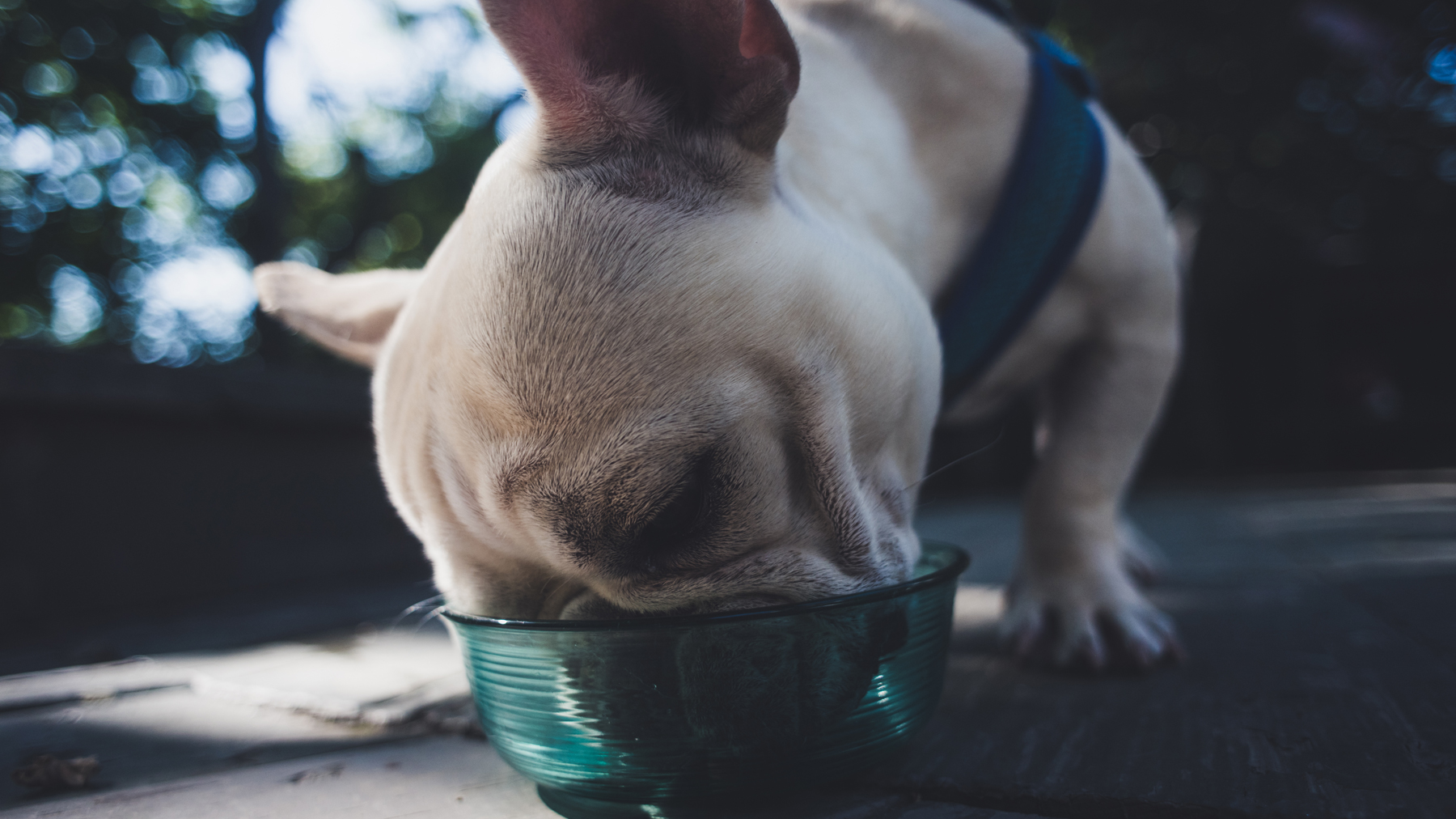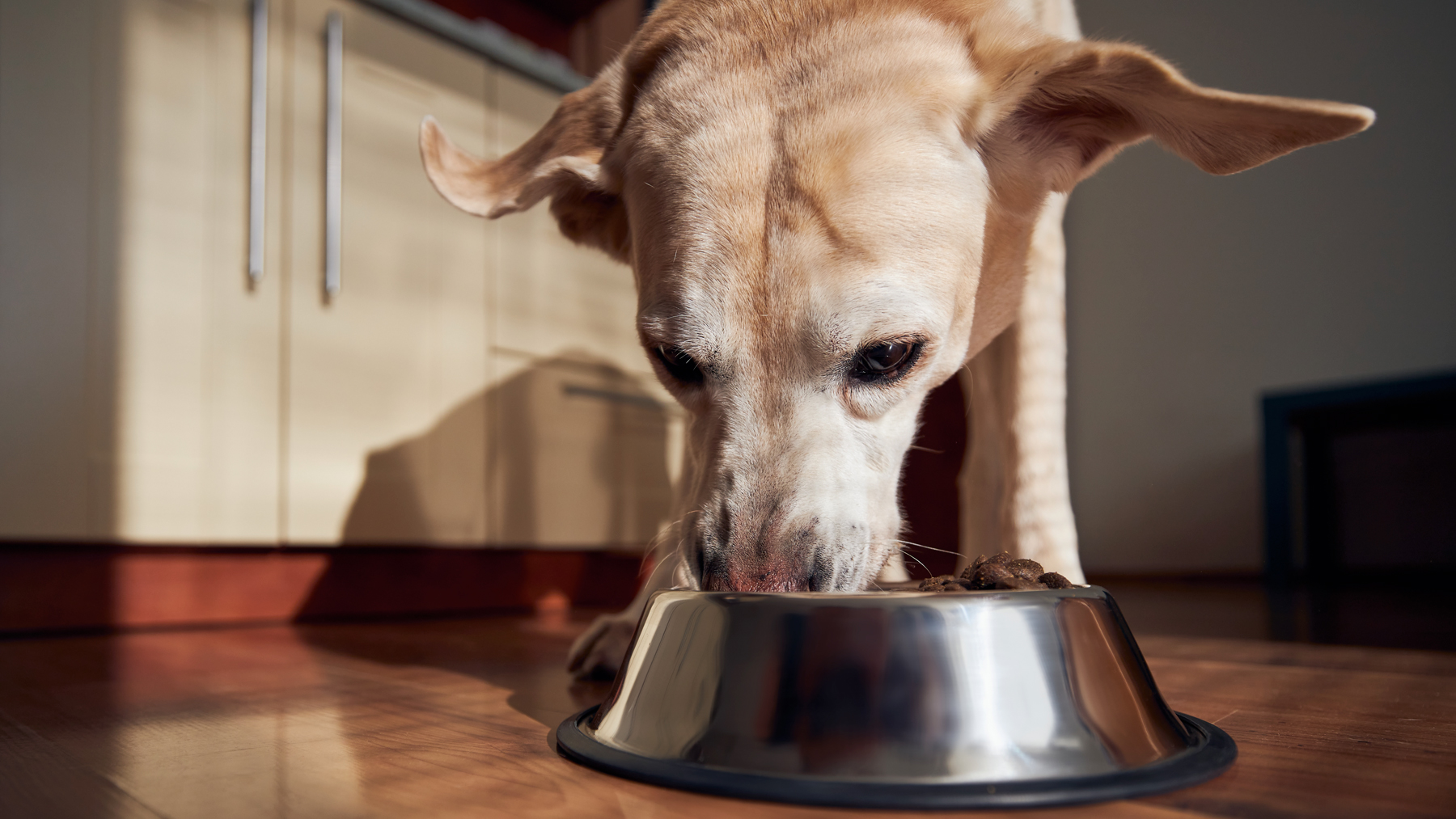Why does my dog eat fast?
Is it a problem if my dog eats fast? We reveal why your dog could be emptying their food bowl especially fast and ways to slow this down

Wondering, why does my eat fast? If your dog eats extra quick, hoovering up his or her food in seconds and gnawing through the longest lasting dog chews in record-breaking time, there is usually a reason for this rather than your dog just being greedy. Whilst there are a few causes for you to investigate why your dog eats too fast, and solutions to rectify the habit, it’s important to understand that a dog who eats too fast is at risk of serious complications.
A dog wolfing down his or her food, especially those with deep chests such as Bassets, Boxers and Greyhounds makes them prone to a condition known as GDV in dogs (gastric dilatation volvulus) or bloat as it’s more commonly referred to. GDV or bloat occurs when the stomach has filled with gas (possibly due to the amount of air inhaled when eating) causing the stomach to bloat and then twist. It is a medical emergency requiring immediate attention.
Eating food too fast can also cause digestive upsets, pain, and discomfort not to mention a potential choking hazard, but let’s look at how we can tackle the problem of your dog eating too fast and avoid these issues.
Why does my dog eat fast?
The following reasons can be considered as explanations but need to be examined in further detail by you and then a vet as the answer as to why, will be different for every pet.
1) Competition
The most common cause is competition. Eating their food as fast as possible equates to survival in a dog’s mind. If they were fed as a group in the litter, housed in establishments with multiple dogs or other family dogs try to steal their food, they want to gobble it up as quickly as they can so as not to miss out. Even humans and cats (in the household) being around at mealtimes can instigate this lurking anxiety reaction from your dog.
2) Inappropriate or inconsistent feeding
If a dog is fed at different or random times of the day, they are triggered into eating all they can as fast as they can due to the uncertainty of when their next meal is coming. This same reasoning is behind previously mistreated dogs who may have not been fed properly.
3) Underlying illness
Certain conditions such as Diabetes, Cushing's Disease and parasites can cause your dog to be hungrier.
4) Medications
Some medications like steroids cause an increase in appetite meaning your dog has a more vivacious appetite.
5) Low quality food
If their diet is lower quality, it may not provide all the nutrients your dog needs. Therefore, the body naturally asks for more nutrients by making the dog hungry, encouraging him or her to eat more.
6) Incorrect amount of food
Underfeeding your pet. This can happen unintentionally by guessing either your dog’s weight and/or the amount of food to feed your dog rather than weighing the food out.

How do I know if I am feeding my dog enough?
As a general rule, most adult dogs require two meals daily. The amount to feed your dog is based on their weight and will be indicated on the food packaging. It’s a good idea to know the accurate weight of your dog which is easily checked at your local veterinary surgery and not guess it. Guessing can lead to underfeeding and/or overfeeding causing malnutrition (including hunger) and obesity respectively. Other factors to take into account when choosing the amount of food from the food packaging’s guide range, is how active your and your dog’s lifestyle is. For example, working dogs or dogs who are highly athletic and energized on their walks will need more calories than a dog who prefers to snooze the day away with short walks. Any illnesses affecting weight gain or weight loss also need to be accounted for.
A further indicator to know you are feeding your dog enough is your dog’s body condition… you should be able to feel their ribs but not see them and they should have a ‘waist’. A chart by The World Small Animal Association demonstrates a dog’s body condition and score well.
If you are unsure at all, book an appointment with your veterinarian or vet technician to talk about your dog’s specific feeding requirements and needs.
How do I get my dog to stop eating so fast?
If they’re guzzling food due to an underlying medical condition, eating speed should return to a more normal pace once this is resolved or stabilized. It is also prudent to check with your vet about the side effects of any medication your dog may be taking, and how to approach the matter should this be the cause of the speed eating.
Other ways to help slow their eating roll can include one of the following, or you may wish to alternate them.
- Use a slow feeder bowl: Either a commercial one or one made at home. For example, use an upturned small bowl in their feeding dish and fill the food around it or utilize a muffin tin.
- Number of meals: Feed in smaller amounts more frequently.
- Use feeding dispensers or puzzle games: These dispense timed food or puzzles create obstacles and tasks for your dog to overcome before being able to eat the food. Both are good options.
If you’ve ever come across the puzzle toys that resemble a wacky carpet decorated with tufts of fabric, you might have asked yourself ‘are snuffle mats good for dogs?’ Well, broadly, yes. The best snuffle mats for dogs allow you to scatter dry food within them and your dog to use their powerful nose to sniff the kibble out, which provides entertainment and slows down their feeding. - Spread the food around: If using dried food spread the kibble about the area or room where your dog eats. This means they have to search, slowing down their eating time. Refrain from spreading it too thinly though as your dog may become bored with it.
Do slow feed dog bowls work?
The following study by Harper Adams University concluded slow feeder bowls ‘are effective at reducing eating speed’ and will help to increase the challenge of eating their meal although they may become smart and switched on about how to override any puzzles or challenges!
It’s worth remembering what works for some owners and their pets will not work for others, but given the number of styles and variations of quality standards on the market to choose from, trial and error may need to be observed until you find a correct match. The option of alternating bowls is also an option to try to retain interest. However, the study also reported they found no evidence that ‘dogs wanted to have their rate of eating slowed’ and advised caution when considering these products.
According to a research project carried out by DogTV, yes they do. However, it is a case of finding the right feeder for your dog. As they mention, some are better than others, and the quality of slow feeders varies but there are many different styles to choose from and you can alternate between different bowls to remove any issues your dog may find with them.
If you have more unanswered questions about your dog, we have plenty more expert driven advice on our site, for example, find out more about the causes of pale dog gums. Or read some of our writers' first-hand success stories with their pets like how Louise 'tried this ridiculously simple tip and it's stopped my puppy chewing just about everything'.
PetsRadar Newsletter
Get the best advice, tips and top tech for your beloved Pets
Annaliese qualified as a veterinary nurse from Edinburgh and went on to attain a diploma in advanced veterinary nursing in surgery from London. Throughout this time, she worked in both small and mixed veterinary practices and gained head nurse status. Responsible for training other veterinary nurses she also ran the nursing department, nurse clinics, and patient care protocols.
She has looked after 1,000s of patients and owners and created new higher standard nursing regimes, whilst specializing in surgery and anesthesia. After being asked to co-author multiple veterinary nursing textbooks, Annaliese continued to write for further mainstream publications in the UK and USA and after twenty-plus years in both the veterinary and pet care professions, she hung up her scrub suit and now writes full-time.

